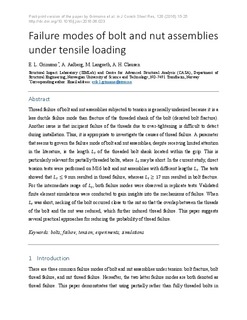| dc.contributor.author | Grimsmo, Erik Løhre | |
| dc.contributor.author | Aalberg, Arne | |
| dc.contributor.author | Langseth, Magnus | |
| dc.contributor.author | Clausen, Arild Holm | |
| dc.date.accessioned | 2017-06-06T12:20:15Z | |
| dc.date.available | 2017-06-06T12:20:15Z | |
| dc.date.created | 2016-07-22T11:27:10Z | |
| dc.date.issued | 2016 | |
| dc.identifier.citation | Journal of constructional steel research. 2016, 126 15-25. | nb_NO |
| dc.identifier.issn | 0143-974X | |
| dc.identifier.uri | http://hdl.handle.net/11250/2444453 | |
| dc.description.abstract | Thread failure of bolt and nut assemblies subjected to tension is generally undesired because it is a less ductile failure mode than fracture of the threaded shank of the bolt (denoted bolt fracture). Another issue is that incipient failure of the threads due to over-tightening is difficult to detect during installation. Thus, it is appropriate to investigate the causes of thread failure. A parameter that seems to govern the failure mode of bolt and nut assemblies, despite receiving limited attention in the literature, is the length Lt of the threaded bolt shank located within the grip. This is particularly relevant for partially threaded bolts, where Lt may be short. In the current study, direct tension tests were performed on M16 bolt and nut assemblies with different lengths Lt. The tests showed that Lt≤9 mm resulted in thread failure, whereas Lt≥17 mm resulted in bolt fracture. For the intermediate range of Lt, both failure modes were observed in replicate tests. Validated finite element simulations were conducted to gain insights into the mechanisms of failure. When Lt was short, necking of the bolt occurred close to the nut so that the overlap between the threads of the bolt and the nut was reduced, which further induced thread failure. This paper suggests several practical approaches for reducing the probability of thread failure. | nb_NO |
| dc.language.iso | eng | nb_NO |
| dc.publisher | Elsevier | nb_NO |
| dc.rights | Attribution-NonCommercial-NoDerivatives 4.0 Internasjonal | * |
| dc.rights.uri | http://creativecommons.org/licenses/by-nc-nd/4.0/deed.no | * |
| dc.title | Failure modes of bolt and nut assemblies under tensile loading | nb_NO |
| dc.type | Journal article | nb_NO |
| dc.type | Peer reviewed | nb_NO |
| dc.source.pagenumber | 15-25 | nb_NO |
| dc.source.volume | 126 | nb_NO |
| dc.source.journal | Journal of constructional steel research | nb_NO |
| dc.identifier.doi | 10.1016/j.jcsr.2016.06.023 | |
| dc.identifier.cristin | 1368964 | |
| dc.description.localcode | © 2016 Elsevier Ltd. All rights reserved. This is the authors' accepted and refereed manuscript to the article. Locked until 30 November 2018 due to copyright restriction | nb_NO |
| cristin.unitcode | 194,64,45,0 | |
| cristin.unitname | Institutt for konstruksjonsteknikk | |
| cristin.ispublished | true | |
| cristin.fulltext | postprint | |
| cristin.qualitycode | 1 | |

